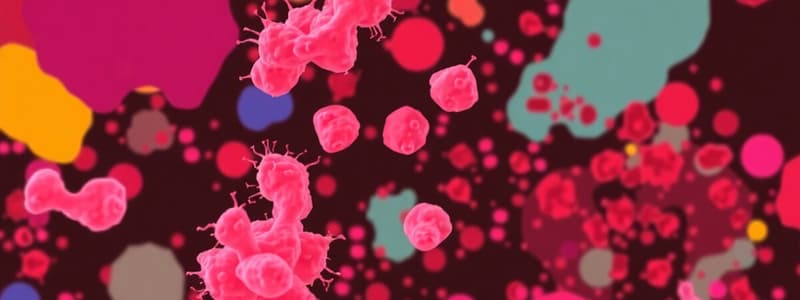Podcast
Questions and Answers
Which virulence factor of Staphylococcus aureus inhibits phagocytosis, disrupts chemotaxis, and affects mononuclear cell proliferation?
Which virulence factor of Staphylococcus aureus inhibits phagocytosis, disrupts chemotaxis, and affects mononuclear cell proliferation?
- Teichoic acids
- Cell wall Protein A
- Lipoteichoic acid
- Capsule (correct)
Which of the following best describes the role of Protein A in the virulence of Staphylococcus aureus?
Which of the following best describes the role of Protein A in the virulence of Staphylococcus aureus?
- It lyses red and white blood cells.
- It destroys the stratum granulosum of the epidermis.
- It binds antibodies to block complement activation and inhibit phagocytosis. (correct)
- It stimulates T-cell proliferation and cytokine release.
What is the primary mechanism by which exfoliative toxins contribute to the pathogenesis of Staphylococcus aureus infections?
What is the primary mechanism by which exfoliative toxins contribute to the pathogenesis of Staphylococcus aureus infections?
- Destroying the stratum granulosum of the epidermis. (correct)
- Converting fibrinogen to fibrin, promoting clot formation.
- Degrading hyaluronic acids in the host extracellular matrix.
- Stimulating T-cell and macrophage release of cytokines.
How does coagulase contribute to the virulence of Staphylococcus aureus?
How does coagulase contribute to the virulence of Staphylococcus aureus?
What role do lipases play in the pathogenesis of Staphylococcus aureus infections?
What role do lipases play in the pathogenesis of Staphylococcus aureus infections?
Which of the following is a characteristic feature of impetigo caused by Staphylococcus aureus?
Which of the following is a characteristic feature of impetigo caused by Staphylococcus aureus?
How do carbuncles differ from furuncles in Staphylococcus aureus infections?
How do carbuncles differ from furuncles in Staphylococcus aureus infections?
What is the primary characteristic of acute endocarditis caused by Staphylococcus aureus?
What is the primary characteristic of acute endocarditis caused by Staphylococcus aureus?
How does osteomyelitis caused by Staphylococcus aureus typically manifest in children?
How does osteomyelitis caused by Staphylococcus aureus typically manifest in children?
What is the mechanism by which toxic shock syndrome toxin-1 (TSS-1) causes systemic effects?
What is the mechanism by which toxic shock syndrome toxin-1 (TSS-1) causes systemic effects?
Which of the following is the primary cause of scalded skin syndrome (Ritter's disease)?
Which of the following is the primary cause of scalded skin syndrome (Ritter's disease)?
What is the typical presentation of food poisoning caused by Staphylococcus aureus?
What is the typical presentation of food poisoning caused by Staphylococcus aureus?
What is the role of hyaluronidase in Staphylococcus aureus pathogenesis?
What is the role of hyaluronidase in Staphylococcus aureus pathogenesis?
Which condition is Staphylococcus saprophyticus most commonly associated with?
Which condition is Staphylococcus saprophyticus most commonly associated with?
In addition to Staphylococcus aureus, which other bacteria is also known to cause impetigo?
In addition to Staphylococcus aureus, which other bacteria is also known to cause impetigo?
What is the significance of Staphylococcus being catalase-positive?
What is the significance of Staphylococcus being catalase-positive?
Which feature distinguishes Staphylococcus aureus from other Staphylococcus species?
Which feature distinguishes Staphylococcus aureus from other Staphylococcus species?
What is the role of nucleases in Staphylococcus aureus virulence?
What is the role of nucleases in Staphylococcus aureus virulence?
Which of the following toxins produced by Staphylococcus aureus is classified as a superantigen?
Which of the following toxins produced by Staphylococcus aureus is classified as a superantigen?
Which of the following describes the function of fibrinolysin (staphylokinase)?
Which of the following describes the function of fibrinolysin (staphylokinase)?
What is a key characteristic of infections caused by coagulase-negative Staphylococcus (CoNS)?
What is a key characteristic of infections caused by coagulase-negative Staphylococcus (CoNS)?
What is the initial manifestation of scalded skin syndrome (Ritter's disease)?
What is the initial manifestation of scalded skin syndrome (Ritter's disease)?
Which of the following toxins results in significant damage to the host by inducing massive immune responses?
Which of the following toxins results in significant damage to the host by inducing massive immune responses?
How do teichoic acids contribute to the virulence of Staphylococcus aureus?
How do teichoic acids contribute to the virulence of Staphylococcus aureus?
What is the function of Panton-Valentine leukocidin (PVL)?
What is the function of Panton-Valentine leukocidin (PVL)?
Flashcards
Catalase
Catalase
Enzyme that converts hydrogen peroxide to water and oxygen, helping bacteria resist oxidative stress.
Staphylococcus aureus
Staphylococcus aureus
Most virulent strain of Staphylococcus, a leading cause of infectious disease, known for its distinctive golden color due to carotenoid pigments.
Capsule of S. aureus
Capsule of S. aureus
Inhibits phagocytosis, disrupts chemotaxis, and reduces mononuclear cell proliferation, aiding in S. aureus virulence.
Teichoic acids
Teichoic acids
Signup and view all the flashcards
Lipoteichoic acid & Peptidoglycan Layer
Lipoteichoic acid & Peptidoglycan Layer
Signup and view all the flashcards
Cell wall Protein A
Cell wall Protein A
Signup and view all the flashcards
Biofilm
Biofilm
Signup and view all the flashcards
Cytotoxins
Cytotoxins
Signup and view all the flashcards
Exfoliative toxins (A & B)
Exfoliative toxins (A & B)
Signup and view all the flashcards
Enterotoxins
Enterotoxins
Signup and view all the flashcards
Toxic shock syndrome toxin -1
Toxic shock syndrome toxin -1
Signup and view all the flashcards
Superantigens
Superantigens
Signup and view all the flashcards
Coagulase
Coagulase
Signup and view all the flashcards
Fibrinolysin (Staphylokinase)
Fibrinolysin (Staphylokinase)
Signup and view all the flashcards
Hyaluronidase
Hyaluronidase
Signup and view all the flashcards
Lipases
Lipases
Signup and view all the flashcards
Nucleases
Nucleases
Signup and view all the flashcards
Folliculitis
Folliculitis
Signup and view all the flashcards
Carbuncles
Carbuncles
Signup and view all the flashcards
Acute endocarditis
Acute endocarditis
Signup and view all the flashcards
Osteomyelitis
Osteomyelitis
Signup and view all the flashcards
Scaled skin syndrome
Scaled skin syndrome
Signup and view all the flashcards
Food poisoning
Food poisoning
Signup and view all the flashcards
Staphylococcus epidermidis
Staphylococcus epidermidis
Signup and view all the flashcards
Staphylococcus saprophyticus
Staphylococcus saprophyticus
Signup and view all the flashcards
Study Notes
- Staphylococcus are catalase-positive, non-motile, and do not form spores
- Catalase converts hydrogen peroxide to water and oxygen, aiding resistance to oxidative stress
- Staphylococcus aureus is the most virulent strain and a leading cause of infectious disease
- Carotenoid pigments give S. aureus a distinctive golden color
Virulence Factors of S. aureus
- Capsule inhibits phagocytosis, disrupts chemotaxis, and prevents mononuclear cell proliferation
- Teichoic acids bind S. aureus to fibronectin
- Lipoteichoic acid and peptidoglycan layer trigger macrophage release of IL-1 and Tumor Necrosis Factor, causing hypotension and septic shock
- Cell wall Protein A binds antibodies, blocks complement activation, and inhibits phagocytosis
- Biofilm adheres bacterial colonies and debris to tissues, reinforcing adhesion and shielding from immune cells and antibiotics
- Cytotoxins (alpha, beta, delta, gamma, and Panton-Valentine leukocidin) lyse red and white blood cells
- Exfoliative toxins A & B are proteases that destroy the stratum granulosum of the epidermis
- Enterotoxins stimulate T-cell and macrophage release of cytokines and trigger Mast cell degranulation, resulting in peristalsis and vomiting
- Toxic shock syndrome toxin-1 stimulates T cell proliferation and T cell and macrophage release of IL1, IL-2, and TNF, causing blood vessel leakage
- Superantigens like Exfoliative toxin A, Enterotoxin, and TSS-1 induce massive immune responses that cause significant damage to the host
- Coagulase converts fibrinogen to fibrin to promote clot formation and clumping, protecting S. aureus from host defenses
- Fibrinolysin (staphylokinase) dissolves fibrin clots, potentially allowing spread to new niches
- Hyaluronidase degrades hyaluronic acids in host extracellular matrix
- Lipases free fatty acids; they are thought to inhibit host granulocytes, inactivate bactericidal lipids, and promote biofilm formation
- Nucleases hydrolyze DNA and aid in bacterial evasion of Neutrophil Extracellular Traps (NETS)
Purulent Infections
- Impetigo occurs on limbs and face, with flat, reddened areas and pustules that crust upon rupture
- Group A streptococci also cause some forms of impetigo
- Folliculitis is an infection of the hair follicle; styes are infections of eyelash follicles
- Furuncles (boils) are larger, raised pus-filled nodules; surgical drainage is sometimes necessary
- Carbuncles are furuncles that coalesce and affect deeper subcutaneous tissues; bacteremia leads to chills and fever
- Wound infections can also be caused by S. aureus, particularly in patients with compromised immune systems
- Acute endocarditis occurs when bacteria and cellular debris accumulate in vegetations and damage cardiac valves
- Impaired blood flow can occur, and vegetations that break free can embolize
- Pneumonia presents with infiltrates and consolidation or abscesses caused by cell-damaging toxins and enzymes
- Empyema is the accumulation of pus in the pleural cavity
- Osteomyelitis occurs when S. aureus infects the bones; early onset is characterized by pain and fever
- In children, infection involves the metaphyseal area of long bones
- In adults, infection tends to occur in the vertebral bodies
- In subacute osteomyelitis, localized infection within the bone can produce Brodie's abscesses
Toxin-Mediated Infections
- Scalded skin syndrome (Ritter's disease) is caused by exfoliative toxins, primarily affects newborns and young children
- Disease onset is abrupt, beginning with perioral inflammation followed by superficial cutaneous blistering, then epithelial desquamation
- Antibodies appear within 7-10 days, scarring is unusual, and mortality rate is low
- Food poisoning is caused by ingestion of enterotoxins, which produces nausea, vomiting, and diarrhea
- Toxic shock syndrome toxin-1 penetrates mucosal barriers and induces fever, hypotension and shock, and rash
- Because it travels in the bloodstream, the toxin causes damage to multiple organ systems
Coagulase-Negative Staphylococcal Strains (CONS)
- CONS are often associated with infections of prosthetic joints and valves as well as catheters and shunts
- Staphylococcus epidermidis
- Staphylococcus saprophytic is associated with urinary tract infections in sexually active young women
- Staphylococcus lugdunensis is particularly associated with native valve endocarditis
- Staphylococcus haemolyticus
Studying That Suits You
Use AI to generate personalized quizzes and flashcards to suit your learning preferences.





